
- Index
- Amp Hours
- Brand
- Length
- Model
- 110ah (9)
- 12v 100ah (15)
- 12v 200ah (14)
- Amp9045 (30)
- Camper Van Battery (17)
- Campervan Battery (9)
- Hy-vb Series (16)
- L35-115 (17)
- L36-100 (17)
- L36-efb (12)
- Leisure Battery (75)
- Leisure Plus (11)
- Lf4330 (9)
- Lv26mf (15)
- Relay (35)
- Storage Battery (11)
- Trade (10)
- Xv110 (12)
- Xv31 (18)
- Xv31mf (16)
- ... (6420)
- Type
- 12 V (27)
- Agm Deep Cycle (25)
- Batt (27)
- Battery (520)
- Battery Charger (45)
- Deep Cycle (73)
- Dual Purpose (136)
- Electrical Systems (82)
- Electrics (648)
- Lead Acid Battery (162)
- Leisure Battery (39)
- Lifepo4 Battery (84)
- Numax Leisure (37)
- Powerline Leisure (96)
- Solar Panel (42)
- Split Charge Relay (35)
- Starter Battery (57)
- Supply Battery (27)
- Vrla Agm Battery (72)
- Wet (217)
- ... (4337)
- Vehicle Type
LiFePo4 Battery 12.8V Lithium-Ion Iron Phosphate 12V Leisure Solar Caravan
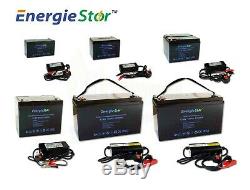
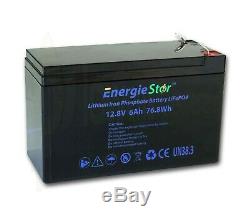
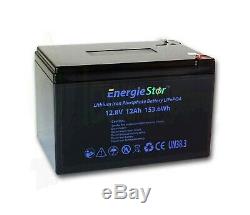
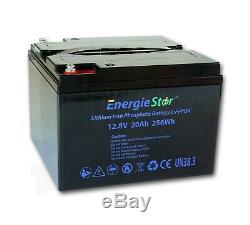

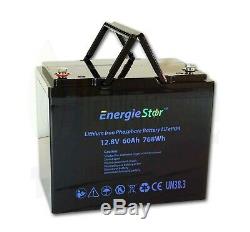
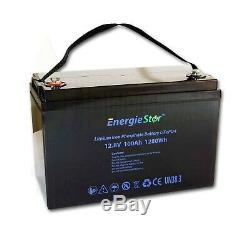
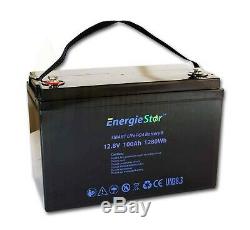
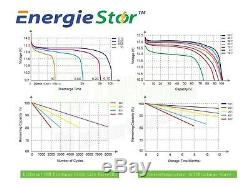
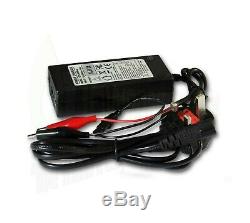


Solar Panels & Charging Kits. Preferred Minimum Charge Current, 0.1C (Amps). Standard Continuous Discharging Current, 0.5C (Amps). Continuous Discharging Current, 1C (Amps). Peak Discharging Current for only 3-5 Seconds, 2C (Amps). Over-Charge, Over-Discharge, Overcurrent and Short Circuit. D, after this, 80% capacity remaining. Double the usable power compared to Lead Acid Batteries and half the battery weight. Can last 50 Times longer than Lead Acid Batteries. Capable of 3000 cycles at 80% depth of discharge (DOD), or 5000 cycles at 50% DOD far outperforming lead acid batteries. LiFePO4 is the safety lithium battery chemistry. All our batteries are extensively tested to comply with UN38.3. See UN38.3 testing procedure below. Our Lithium Batteries can allow up to 100% depth of discharge, which is double the DOD compared to lead acid batteries which only recommend 30-50% DOD. Advanced built-in Battery protection circuit board inside the casing with integrated battery management system (BMS) and safety switch on all models. This also protects against over charging and over discharge helping to maintain a long battery life. Compatible with Lead Acid Battery chargers, although a lithium battery charger is recommended to ensure the longest life. Can have any mounting position, even upside down as long a terminals are protected. No explosive gases vented like lead acid, therefore do not require ventilation. No Risk of battery acid leakage. Our LiFePO4 batteries can still be connected in series and parallel like lead acid. Lithium-Ion is now becoming the battery of choice for everything from electric cars to multi megawatt grid scale storage batteries. FACT, our 60Ah (768Wh) battery has more usable power in it that a 100Ah Lead Acid battery (625Wh). You can connect up to 8 LiFePO4 batteries in parallel giving you a battery bank capacity of up to 800Ah. EnergieStor LiFePO4 Lithium Battery chargers. These are designed to provide the slightly higher charge voltage to Lithium LiFePO4 batteries that is usually given out by Lead Acid battery chargers. These LiFePO4 Lithium battery chargers should always be used with Lithium batteries to ensure long service life. 2A Model - for 6Ah EnergieStor Battery, Dimensions WxHxL (mm) 50x33x170. 3A Model - for 12Ah EnergieStor Battery, Dimensions WxHxL (mm) 50x33x170. 5A Model - for 20Ah EnergieStor. Battery, Dimensions WxHxL (mm) 50x33x170.
10A Model - for 60Ah EnergieStor. Battery, Dimensions WxHxL (mm) 75x50x190. 20A Model - for 100Ah EnergieStor. Battery, Dimensions WxHxL (mm) 95x55x230.
Disadvantages of Old Technology Lead Acid Batteries. Lead Acid batteries were not perfect and had their own safety issues, as below.
A lead-acid battery must be securely mounted to avoid acid spillage. They discharge a mix of hydrogen and oxygen which is created during higher charging levels. This can activate gas alarms such as a carbon-monoxide detectors. Lead Acid battery gas is explosive and if it is ignited, the casing of a battery can be blown apart and its acid released, leading to injury or flesh burns. Accordingly, when charging a battery or disconnecting leads after a charge, ensure there are no naked flames nearby.
Even a lighted cigarette can ignite the gas. It is time to phase out lead acid batteries due to their weight, dangerous acid base and outdated efficiency for these reasons.1, Limited Useable Capacity, 30 to 50% DOD only. 2, Limited Cycle Life, maybe just 200 to 500 cycles, replacement maybe every 2 years.
3, Slow & Inefficient Charging, the final 20% of lead acid battery capacity can not be fast charged. 4, Wasted Energy, as much as 15% of the energy put into them is wasted due to inherent charging inefficiency. So if you provide 100 amps of power, youve only storing 85 amp hours.
100% DOD will reduce cycle life. 30% means using only 30% of the battery between each charge/ discharge cycle will give a very long cycle life for many years.
As power is discharged from the battery, the battery voltage slowly drops which can be used to determine depth of discharge, (see our battery performance graphs in images). Cheap lead acid can degrade in just a few 100% discharges with battery suplation and dead a battery that will not hold charge very quickly. Typical lead acid batteries are usually around 200 to 500 cycles if the are well maintained with no more than 30 to 50% discharge. These Lithium batteries can be 2000 to 5000 cycles depending on the depth of discharge.One cycle is typical discharge to 30, 50 or 80% then full recharge, then next discharge cycle. The maximum number of amps in the battery discharged over a moderate discharge rate.
The number of watt hours in a battery is simply the battery voltage, say 12.8V multiplied by the Battery Ah, i. 12.8 x 100Ah = 1280Wh. This means, at 100% discharge, 1 watt can be discharged from this battery for 1280 hours, or 100 watts can be discharged from this battery for 12.8 hours.Note, the higher the battery discharge rate less watt hours maybe available, this applies to all types of batteries. Lithium Battery UN38.3 Testing Procedure. Test 1 - Altitude Simulation.
Batteries are stored at a pressure of 11.6 KPa (simulating 50,000ft aircraft altitude) for at least six hours at 20°C. After the test, there is no leakage, no venting, no disassembly, no rupture, no fire and battery voltage is stable TEST PASS, ALL MODELS. Batteries are stored for at least 12 hours at a temperature of 72°C followed by storage of 12 hours at a temperature of - 40C. The procedure is to be repeated 10 times. All test batteries are then stored for 24 hours at 20°C.
Batteries are firmly secured to the platform of a vibration machine. The vibration shall be a sinusoidal waveform with a logarithmic sweep between 7 and 200Hz and back to 7Hz, traversed every 15 minutes. This cycle shall be repeated 12 times for a total of three hours. One of the directions of vibration must be perpendicular to the terminal face.
Batteries are secured to a testing machine by means of a rigid mount which will support all mounting surfaces of the battery. Each battery is subjected to a shock of peak acceleration depending on the mass of the battery. Each battery is subjected to 3 shocks in the positive direction followed by three shocks in the negative direction for a total of 18 shocks. Test 5 - External Short Circuit. Batteries to be tested are first heated to 57°C.The battery it is then subjected to one short circuit by joining the positive and negative terminals with metal wire of less than 0.1 Ohm for at least one hour. After heating, the short circuit and cooling down phases are conducted at ambient temperature.
In order to pass this test, batteries must not have an external temperature exceeding 170°C, there is no leakage, no venting, no disassembly, no rupture and no fire. A component cell is to be crushed between two flat surfaces.
The crushing is to be continued until the first of three options is reached below. A, the applied force reaches 13KN approx. B, the voltage of the cell drops at least 100 mV. C, the cell is deformed by 50% or more of its original thickness. Each component cell is to be subjected to one crush only. The test sample object is monitored for a further six hours. Requirement component cells will pass this test, so long as their external temperature does not exceed 170°C, there should be no disassembly or fire during the test and within six hours after the test.A charge current is applied to the battery which is twice the manufacturers recommended maximum continuous charge current. The test duration is 24 hours. Requirement batteries will meet this requirement if there is no leakage, no venting, no disassembly, no rupture and no fire within seven days after the test. Each cell is force discharged for a time interval (in hours) equal to its rated capacity divided by the initial test current. Requirement component cells meet this requirement if there is no disassembly and no fire during the test and within seven days after the test.
Please note: We try to dispatch the same day however sometimes this is not possible due to our collection times. To comply with all UK building regulations any electrical work should be carried out by a UK certified electrician.
All electricity should be switched off prior to ANY electrical work being carried out. Low Energy Supermarket was founded in 2010, we offer various energy saving products which help to reduce the ever rising energy bills. We only offer quality products at a competitive price. Get all the Latest News, Updates and Special Offers about Our Store.We are pleased to accept the following credit cards. The item "LiFePo4 Battery 12.8V Lithium-Ion Iron Phosphate 12V Leisure Solar Caravan" is in sale since Tuesday, December 3, 2019. This item is in the category "Home, Furniture & DIY\DIY Materials\Electrical Supplies\Alternative Energy Supplies\Solar Power Supplies\Solar Panels & Kits". The seller is "lowenergysupermarket" and is located in Warrington **No Collections Sorry **.
This item can be shipped to United Kingdom, Antigua and barbuda, Austria, Belgium, Bulgaria, Croatia, Cyprus, Czech republic, Denmark, Estonia, Finland, France, Germany, Greece, Hungary, Ireland, Italy, Latvia, Lithuania, Luxembourg, Malta, Netherlands, Poland, Portugal, Romania, Slovakia, Slovenia, Spain, Sweden, Australia, United States, Bahrain, Canada, Brazil, Japan, New Zealand, China, Israel, Hong Kong, Norway, Indonesia, Malaysia, Mexico, Singapore, South Korea, Switzerland, Taiwan, Thailand, Bangladesh, Belize, Bermuda, Bolivia, Barbados, Brunei darussalam, Cayman islands, Dominica, Ecuador, Egypt, Guernsey, Gibraltar, Guadeloupe, Grenada, French guiana, Iceland, Jersey, Jordan, Cambodia, Saint kitts and nevis, Saint lucia, Liechtenstein, Sri lanka, Macao, Monaco, Maldives, Montserrat, Martinique, Nicaragua, Oman, Pakistan, Peru, Paraguay, Reunion, Turks and caicos islands, Aruba, Saudi arabia, South africa, United arab emirates, Ukraine, Chile, Bahamas, Colombia, Costa rica, Dominican republic, Guatemala, Honduras, Jamaica, Kuwait, Panama, Philippines, Qatar, El salvador, Trinidad and tobago, Uruguay, Viet nam.- Unit Type: Unit
- Unit Quantity: 1
- Colour: Black
- Product Line: Lithium Battery
- MPN: Lithium_Master
- Room: Boat
- Brand: EnergieStor
- Application: Boat/RV/Vehicle

